>> Back to The HooK front page
COVER- Extreme makeover-- Paramount edition: Tarting up a tattered theater
Published January 6, 2005, in issue 0401 of the Hook

BY LAURA PARSONS
The night before glittering diamonds and tailor-made tuxedos flooded the lobby of the Paramount and less than 24 hours before Tony Bennett crooned, "I left my heart in San Francisco," under the theater's newly restored chandeliers, a gold brocade couch occupied center stage. It was 11pm. Workmen milled about taking care of last-minute details, as Paramount executive director Chad Hershner and board members Alison Dickie and Michael Gaffney stood mulling how to transport the sofa to an upstairs lounge.
Exhausted, the three plopped down on the cushions and stared out across the empty theater. "We found ourselves just sitting there for an hour, just looking at it from the stage," Dickie recalled. "It was a sea of gold."
Hershner added, "It's going to be one of those times that we'll look back on 15 years from now and say, 'Remember when we sat on the couch and spent an hour and a half just enjoying the surroundings."
Fifteen years past, that "sea of gold" was more like a brackish puddle. Crumbled plaster littered the interior of the long-dark theater. Moths gnawed its carpets, and mildew crept across its seats. Like an heiress turned cart-pushing bag lady, the once-grand Paramount was down-and-out and destined for the wrecking ball when a group of concerned citizens rallied to its rescue.
For nearly a decade and a half, local arts and architecture fans devoted time and energy (and money!) to restoring the Paramount to its original grandeur. And when the construction crew at last removed the bandage-like plywood barrier from the front of the theater in mid-December, revealing the theater's renewed opulence, it was the final chapter in a riches-to-rags-to-riches story worthy of the stage.
Back in the Day
Although the Paramount's re-opening gala on December 15 dazzled, with a red carpet stretching onto the mall and searchlight beams crisscrossing the sky, it lacked the eight "aerial bombs" that shot from the roof when the Paramount first opened its doors on November 25, 1931. At the time, "A line, with people three and four abreast, was extended down the block to Second Street East, and around the square to the postoffice," reported The Daily Progress in its November 27, 1931 edition.
Those lucky enough to make it into the theater that night enjoyed the "thrilling football drama Touchdown" along with the musical stylings of a Wurlitzer-playing musician named "Brownie." According to the Progress, "The popular impression of the playhouse was that it is a place of charming design, harmonious varicolored lights and luxurious seats."
In creating the state-of-the-art theater (it was even air-conditioned!), the Chicago architectural firm Rapp & Rapp opted to ignore the then-current rage for art deco and instead created something distinctively Virginian. Octagonal in shape, the Paramount was an ode to Thomas Jefferson, with two colossal colonial-era murals painted on silk and plaster molding budding with dogwood blossoms. Less admirable was its separate entrance on Third St. for African-Americans, who ascended a staircase to segregated seating in the balcony.
Although forgotten today, Touchdown played for the Paramount's first three months. The shows that followed during the next decades were a mix of movies and live shows. A midnight fire in January 1934 severely damaged the stage, forcing the theater to cancel the next day's acrobatic performance by "Alexander's Variety Wonders." Later that year, police charged a Paramount fan dancer named Corinne Reynolds with indecency, alleging she was baring all behind her feathers. A judge dismissed the case, however, when Reynolds produced her near-nude costume bits in court.
Sandy DeKay, Hershner's assistant and the Paramount's unofficial historian, noted the Paramount was also involved in community affairs from the outset. "During the '30s and the Great Depression," she said, "the management would hold movie events, free of charge to the organizers, in order to raise money or goods for such worthy causes as feeding and clothing local children."
During World War II, the Paramount held events to encourage people to donate blood and buy war bonds. DeKay said one old-timer even told her that someone drew the faces of Hitler, Stalin, and Tojo above the men's urinals in the theater.
The Dark Years
But the Paramount's good times stopped rolling in the late 1960s and early 70s. As businesses moved out to new-fangled malls like Barracks Road, Charlottesville's downtown became desolate. Adding insult to injury, the already decrepit Paramount caught fire again in March 1974. The minor blaze caused only $1,000 damage, but it marked the end of an era.
The families of the Paramount's original owners, Hollis Rinehart and P.H. Faulconer, sued current tenants ABC Southeastern Theaters, Inc. for allowing the Paramount to fall into disrepair while ABC built a new movie theater on Hydraulic Road (the Terrace Triple, which, ironically, now sits abandoned-- see "Recent Passed," The Hook, April 14, 2004). While the case was in court, the Paramount shut its doors for good June 30, 1974. The last picture show? A "blacksploitation" film entitled Thomasine and Bushrod.
Although Charlottesville made a valiant attempt in 1976 to revitalize downtown by bricking over Main Street to create a pedestrian mall-- an initial bust despite its now booming popularity-- the Paramount remained shuttered as dust settled on its once-grand remains. In 1981, the owners proposed razing the building to make way for an underground parking garage, and the city gave them the go-ahead. Fortunately, the demolition was delayed. A few years later, a UVA professor proposed turning the old theater into a jazz hall of fame, but that plan, too, fizzled.
In 1986, Charles Knight penned an editorial for The Daily Progress's "Your Right to Say It" page. "I once stood inside the Paramount Theater building-- and it is an old dump-- but I imagine it as it was in its heyday, and how it could be again," he wrote. Knight's opinion piece brought several letters of agreement, including one from Sandy DeKay.
The following year, developer Tom Hickman bought the theater with an eye to transforming it into a restaurant, a nightclub, or possibly condominiums. At the same time, Patricia Kluge hinted she wanted to acquire the Paramount to house the fledgling Virginia Film Festival, known then as "A Virginia Homecoming." The Festival went forward, but the theater stalled.
By 1989 Hickman had come to consider the Paramount an albatross that could only be removed from his neck through demolition. Recognizing the Paramount's days were numbered, a group of concerned citizens banded together to try to buy the Paramount and approached Hickman about a stay of execution. He issued a deadline for an initial deposit on the theater. The group failed to meet it. But perhaps influenced by a 1990 City Office for Economic Development report that cited the Paramount's restoration as a key to downtown revitalization, Hickman relented and offered an extension.
In 1992, the newly formed nonprofit The Paramount Theater, Inc. assumed ownership of the dilapidated theater and began the enormous task of raising funds for its makeover. An early pronouncement that the theater would operate in the black by hosting shows 200 nights a year brought scathing attacks by business-savvy critics. The final 2004/2005 schedule has 34 shows over six months, nine of which have already sold out, says community relations director Kristen Gleason. To keep the theater in the black, Gleason says 75 percent of the theater's operating budget will come from ticket sales, and the other 25 percent from donations.
New Millennium
When Sheldon Anderson, current president of the Paramount's board of directors, joined the Paramount in 1993, the theater's estimated restoration cost was pegged at $1.6 million.
"At the time I thought, 'Oh my, that's more than we'll ever be able to raise,'" Anderson recalls. Longtime board member Ethel deNeveu said her daughter Kate, now a student at UVA, used to sell lemonade and donate the proceeds to the theater.
The coffers gradually filled, however slowly, and in 2000, the Paramount's board hired executive director Chad Hershner, who had recently raised $17.3 million for the restoration of The Strand Center for the Performing Arts in York, Pa. When Hershner arrived in Charlottesville, the theater's renovation estimate had already escalated to $6.6 million
But Hershner came bursting with ambition and contagious enthusiasm, and he conducted several focus groups to examine the Paramount's potential. With his encouragement, the Paramount plan changed from merely saving the building to transforming it into a first-rate performance venue and community center. The additional cost? A cool $7.8 million.
Undeterred, the Paramount began a capital campaign dubbed "Setting the Stage." Donors began to step up to the plate, with several contributing over a million dollars apiece. Reflecting on her six-year involvement with the theater, major contributor Janice Aron summed up a common attitude, "It's not just money, honestly. It's momentum and energy and optimism-- and board members' painting the bathrooms [of the Paramount's temporary Water Street office]."
Finally, in March 2002, a mound of dirt was heaped onto the Downtown Mall in front of the theater so board members could dig in their shovels, symbolically breaking ground for construction to begin. David Nobles, the project supervisor for Nielson Construction, had gotten his first look at the theater three months earlier, and his first reaction was "What have they done to me?"
Nevertheless, Nielson set up the building to be monitored, installing seismographs, conducting stress tests in nearby buildings, and reinforcing supports to prepare for the first major undertaking: digging a new basement to house dressing rooms and other facilities. A short time later, the Paramount's dusty silk murals no longer flanked the theater's seats and stage; instead they hung above a deep dirt pit.
Even as construction progressed, delays and ever-expanding plans (more money meant more possibilities) pushed the Paramount's anticipated opening date from late 2002 to mid-2003 to sometime during 2004.
A few snags also tangled the works. Besides being inconvenienced by reduced parking along Market Street and Third Street, businesses complained about lack of access and other construction-related problems. The nastiest incident involved concrete seeping into an old city sewer line that ran beneath the Mall. The hardening muck caused waste to back up in several Main Street basements. Eventually City workers had to dig up the Mall itself to resolve the issue.
The Pace Quickens
Determined to open the theater by the end of 2004, the Paramount began to ramp up its preparations in September. In addition to hiring five part-time employees, the theater's full-time staff grew from three to nine. Donald Leffert moved to Charlottesville from Joplin, Missouri, to become the theater's production manager and technical ace. When asked what his reaction was when he first saw the Paramount's still-raw interior, he admitted, "It was actually, 'Is this thing going to be ready?'"
Leffert joined a crew of carpenters and electricians to pull together the technical aspects of the theater. He pointed out the biggest hurdle was "the unknown." "It's always a little nerve-wracking whether if you flip the switch, it all comes on," he explained.
He was surprised and grateful that night after night the construction workers voluntarily stayed up with him as he tested and adjusted equipment, just in case he needed their help. "I'm really kind of proud to have been working with those guys on it," he said.
Another new hire was Alex Caines, who took over as the Paramount's affable house manager. Having grown up going to New York's Radio City Music Hall (his first show was Dumbo), Caines said for 14 years he walked by the Paramount every day, thinking, "Wow, I can't wait to see that open." He began volunteering for the Paramount during the past four years, and in October he left his job as concierge at the Omni to join the theater's fulltime staff. "It was a birthday present to me," he said smiling.
In addition to making sure all the physical areas of the Paramount are up to snuff (to walk with Caines through the theater is to tour someone's trophy house-- he's proud of the 12 handicap-accessible aisles, proud of the 22-stall women's restroom, proud of the diaper-changing area in the men's room), Caines took on the daunting task of coordinating the volunteer ushers and ticket-takers. For the opening night gala he recruited people he'd worked with in the past, but he said, "My phone just kept ringing." Hundreds of people wanted to get involved.
Meanwhile, as time wound down to the December 15 D-day (D, in this case, standing for "Debut"), workmen chiseled the words "Box Office" in granite over the door of the new three-story annex, applied gold leaf to the theater's ornamental molding, carefully hung the newly restored chandeliers from the ceiling, installed the new gold cut-velvet seats, laid carpet, built the bar in the Founders Lounge, installed the showers in the dressing rooms, framed walnut doors, and completed other numerous tasks. Supervisor David Nobles said, "Sixty or 70 of us worked 30-some days straight."
Despite putting in 10- to 12-hour days under the pressure of a ticking clock, carpenter David Walta was impressed by how well everyone cooperated on the project. "I've had a fun time," he reflected. "Everybody got along. This has been real nice."
A Literal Run-Through
During the final seven days leading up to the Paramount's grand re-opening, community relations director Kristen Gleason buzzed about getting programs ready, dealing with press requests, taking ticket orders, and answering questions from the public. "Gosh, there's been so much going on," she said after the opening, " I don't know what I was doing." Board member Michael Gaffney sighed, "I tell you the last week I don't think I got more than four hours of sleep." And Alex Caines discovered "that if I can just run fast enough, I can get it done."
There were moments of doubt mixed in with moments of satisfaction. Executive director Chad Hershner's heart skipped a beat when the City's Building Code inspector announced, "You have a code situation in your bathroom." Hershner replied, "Oh my God, what?" And the inspector pointed out, "You realize you have way more toilets than you need in your bathroom." Hershner sighed with relief
Among the highpoints of the week were the removal of the plywood barrier that had long hidden the theater from public view and the lighting of the marquee. According to Caines, the workmen just stepped back and said, "Wow."
To thank the construction crew for their dedicated long hours, the Paramount hosted a pre-grand-re-opening show, featuring the Canadian Brass, just for workmen's families on December 10. Caines said, "I saw them take their wives and kids around and say, "I did that.'"
The Big Night
At 5:30pm on December 15, less than three hours before Tony Bennett took the stage, staff members were still trying to hang the chandeliers in the Paramount's new ballroom. But an hour later, when the theater's doors re-opened for the first time in 40 years, the be-furred and be-jeweled guests walking the red carpet from the tented outdoor coat check into the theater were oblivious to any last-minute problems.
In the green-and-gold carpeted lobby, waiters serenely carried trays of white wine and shrimp skewers amid what looked like a Charlottesville casting call for Lifestyles of the Rich and Famous. Chamber of Commerce president Tim Hubert joked, "I was waiting for someone to say, 'Who are you wearing?' "
The prolonged anticipation of the Paramount's unveiling seemed to make the occasion that much sweeter for those whose tenacious belief in the theater's potential had finally been vindicated. Smiles and laughs sparkled as much as the diamonds in the house. "It's very, very overwhelming," said Janice Aron, looking lovingly at both the lobby and its occupants. "Don't you feel that?"
Savoring the moment, no one was eager to rush to his or her seat. "We must have flashed the lights three times," the Paramount's Gleason recalled. "People were just so happy to be there." Once inside the auditorium, guests stood and turned around, their heads tilted back, taking in the meticulously restored murals and the elaborate details of the ceiling.
Finally, people sat, and Hershner, decked out in a gold brocade vest and bow tie, boomed, "Welcome to your Paramount Theater!" Following a song-and-dance number by three buxom blondes-- who some mistook for drag queens (Charlottesville is progressive, after all)-- the obligatory thanking of the major donors, the City, the County, the workers, the staff and volunteers, a ribbon cutting, a commemorative-plaque giving (albeit from Tiffany's) and a few scripted-yet-spontaneous words from local celebrities, the lights went down and Tony Bennett's incomparable voice filled the Paramount's restored auditorium.
Bennett spun and danced. He sang "Fly Me to the Moon" un-amplified to demonstrate his delight in the theater's acoustics. His band wowed. The appreciative audience responded with standing ovation after standing ovation.
And then the night was over.
But it was just the beginning of the Paramount's revival celebration.
The Weekend Lineup
Two nights later, people lined up outside the Paramount, as opera diva Denyce Graves finished her on-stage rehearsal at 7:15pm, delaying the theater's opening at 7:30pm. But no one complained, and Graves thrilled the capacity crowd by performing without a microphone. Graves was apparently so taken with the Paramount that following her concert, she remarked to Hershner that she'd like to pack the theater in her suitcase and carry it with her around the world.
The next day the line for the Saturday matinee screening of The Wizard of Oz was reminiscent of the Paramount's opening night in 1931, snaking around the block onto Second Street. It was the same scene all over again for the evening presentation of Casablanca. The movies, at a quarter a pop, provided the first chance for many to see the inside of the Paramount.
But for Charlottesville natives Maxine and Henry Buron and Nancy and Oran Oakey, their Saturday trip to the Paramount was like visiting a long-lost friend. Oran Oakey had worked as a Paramount usher in 1943, and Maxine Buron recalled, "I saw Gone With the Wind here I don't know how many times." Although they agree the restored Paramount has more green whereas the original Paramount had more red, the four are thrilled with the renovation. "I thought it was going down," said Oran Oakey. "I'm glad it didn't."
Leslie and Eric Scholz sat with their 5-year-old daughter Isabel and 8-year-old son Sam in the balcony for The Wizard of Oz. "I thought it was stunning," Leslie said, remarking on the Paramount's interior. "And it's great to have a new place to go!" Isabel Scholz offered a more concise review. How was the movie? "Good." How was the theater? "Good." How were the flying monkeys? "Good."
For sisters Daniella and Tenese Benton, ages 14 and 13, who attended the matinee with their grandmother, Delores Wildy, and cousin Devyn Wildy, it was their first viewing of both the movie and the theater. "It was really nice," said Daniella. "She can't wait to come back and try out for the Amateur Hour," added Delores, referring to the Showtime at the Apollo performance scheduled for May 6.
The final show of the Paramount's debut weekend was the nostalgic song-and-dance revue In the Mood, which played to yet another sold-out house on Sunday, December 19.
As In the Mood's 1940s-era songs lilted in the background (a state-of-the-art sound system carries sound from the stage throughout the theater), Chad Hershner, Alison Dickie, and Michael Gaffney took a well-deserved time-out in the Paramount's upstairs Founders Lounge. "Fabulous!" was Hershner's one-word summary for how the weekend came off. "People have just been so appreciative. People have said everything just seemed to be flawless."
Relieved to have gotten through the Paramount's re-opening without a hitch, the three sat joking together on the same gold brocade sofa they occupied the previous Tuesday night. Suddenly they grew quiet, intent on listening. Dickey whispered, "Do you hear that?" In the Mood had just finished its final song, and applause from the auditorium was thundering through the theater. Three exhausted but delighted smiles spread across their faces. The Paramount lived.
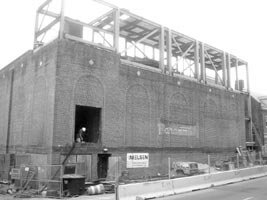
Nielson Construction crews went to work in March 2002, both digging a new basement and adding extra height to the theater structure.
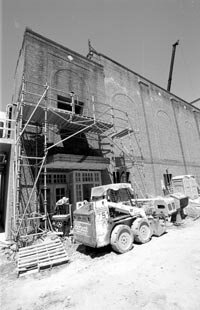
Construction and planning delays pushed opening day from 2002, to 2003 and finally late 2004.
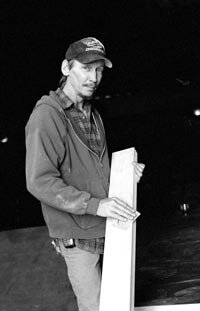
Carpenter Mike Walta was among those putting in 10 and 12-hour days as opening night approached.

House manager Alex Caines gives proud house tours of the new building including the first celebrity signatures on the backstage corridor by the dressing rooms.
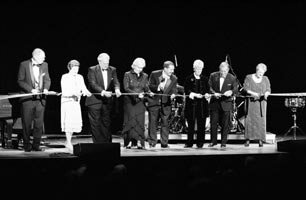
December 15: the Paramount top donors are the official cut-ups.
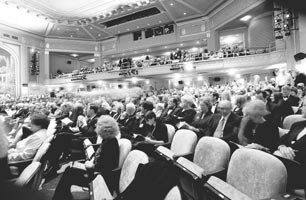
Opening night is black and white and gold all over.

Song and dance numbers warmed up the audience waiting for Tony.
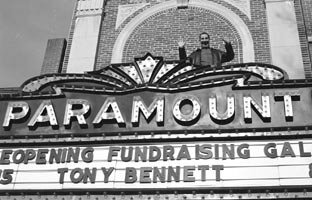
"Welcome to your Paramount Theater!" Chad Hershner's opening line

The stars come out tonight: Hershner greets locals Sissy Spacek, Howie Long and John Grisham on stage
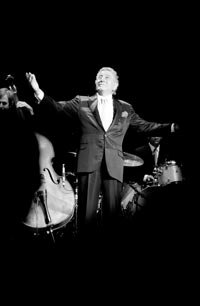
Tony Bennett gave top billing to the new theater's acoustics.
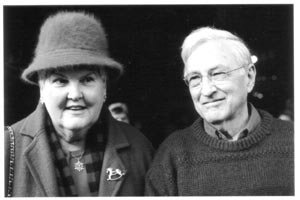
After seeing Casablanca, Charlottesville natives Maxine and Henry Buron recalled old memories (like repeated Gone With the Wind viewings.)

The Scholzes made Saturday's 25-cent showing of The Wizard of Oz a family outing.
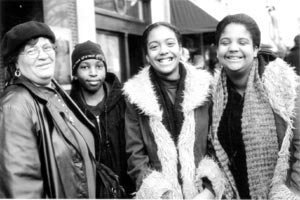
Teenage sisters Daniella and Tenese Benton, plus grandmother Delores and cousin Devyn Wildy, were all smiles after the Paramount's first afternoon movie matinee. More film showings are promised but not yet scheduled.
#
>> Back to The HooK front page
|